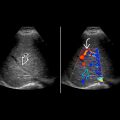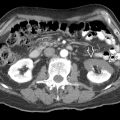KEY FACTS
Terminology
- •
Dilatation of pampiniform plexus > 2-3 mm due to congestion and retrograde flow in internal spermatic vein
Imaging
- •
Dilated serpiginous veins at superior pole of testis
- •
“Flash” of color Doppler with Valsalva
- •
Left (78%), right (6%), bilateral (16%)
- •
Varicose veins > 2-3 mm diameter, increase in size with Valsalva
Pathology
- •
Primary: Incompetent venous valve near junction of left renal vein (LRV) and IVC
- •
Secondary: Obstruction of LRV by renal or adrenal tumor, nodes or rarely SMA compression
Clinical Issues
- •
Most frequent cause of male infertility
- •
Vague scrotal discomfort or pressure when standing
- •
10-15% of men in USA have varicoceles
- •
Subclinical varicocele in 40-75% of infertile men
- •
Catheter embolization, surgical treatment, or sclerotherapy if symptomatic
- •
Emerging research suggests even subclinical varicoceles should be treated
Diagnostic Checklist
- •
Consider left renal vein occlusion by tumor in elderly male patient presenting with recent onset of varicocele
- •
Varicocele diagnosed when vessel > 2 mm during quiet respiration in supine position
Scanning Tips
- •
Unilateral and left-sided varicoceles common; isolated right-sided varicoceles uncommon and should prompt evaluation along IVC to exclude mass
- •
Valsalva with color Doppler essential for diagnosis of small varicoceles
- •
Measure diameter of vein on grayscale; blooming artifact on color Doppler will obscure true diameter and lead to overestimation of diameter
- •
Measure vein from inner wall to inner wall
- •
Avoid mistaking vas deferens as dilated vein
- •
Varicoceles usually lie superior to testicle but may lie posterior or lateral to testicle
 in the spermatic cord and along the posterosuperior aspect of the testis
in the spermatic cord and along the posterosuperior aspect of the testis  .
.
Stay updated, free articles. Join our Telegram channel

Full access? Get Clinical Tree








